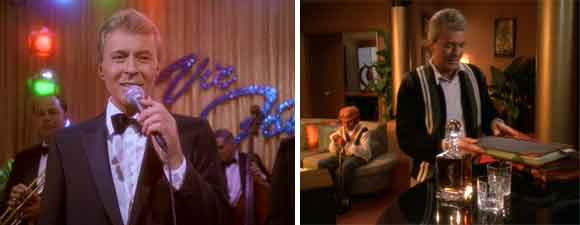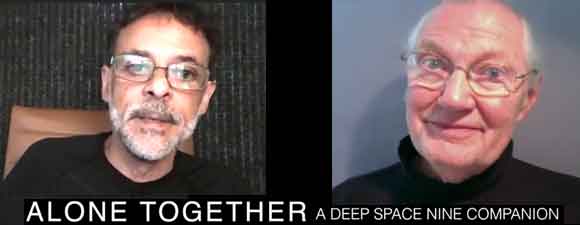Retro Review: The Alternate
6 min readDr. Mora, the Bajoran scientist who first recognized Odo’s sentience, comes to the station to track the shapeshifter’s origins.
Plot Summary: While Odo is taunting Quark about a shady business deal, they are interrupted by Dr. Mora Pel, the Bajoran scientist who first realized that he was a sentient being. Mora has found DNA samples that resemble Odo’s and believes that he can now find Odo’s origins, but Odo, who resented being a prisoner in Mora’s lab, is not fully enthusiastic about having to work with Mora again, though he asks Sisko to borrow a runabout so that he and Mora can be taken by Dax to the Gamma Quadrant for further study. On the planet where the DNA was discovered, the group finds a small life form with similar DNA to Odo’s. As they prepare to leave with a carved stone among the ruins, an earthquake hits and volcanic gas knocks out the humanoids, who Odo rescues. Back on the station, O’Brien has trouble pinning down the life form’s patterns, and later, an intruder destroys nearly everything in the science lab, leaving no trace of the alien. O’Brien suspects the life form itself must have broken out of the lab and a search begins. O’Brien finds the dead remains of the life form, but while performing a necroscopy, Bashir is attacked by a creature he can’t identify. Dax realizes that the being from the planet is not the same being affecting the station’s people and power, and Mora determines that the attacker’s DNA is in fact Odo’s. He warns Odo, who says that he was regenerating during the attacks and is furious at Mora’s interference, believing that Mora is once again infringing on his own right to determine his destiny. Though Mora believes the volcanic gas and not Odo’s psyche is to blame for the attacks, he insists that Odo return to the lab with him, which makes Odo so angry that he becomes the violent creature that attacked Bashir. With Mora’s help, Sisko lures Odo to the Promenade, where the crew is able to capture him and restore him to his usual form. Once Bashir has purged the gas from Odo’s cellular structure, Mora apologizes for his meddling and Odo agrees that they can remain in touch as equals.
Analysis: I’m a bit ambivalent about “The Alternate,” which provides some much-needed and much-appreciated information about Odo’s background and introduces us to the fascinating, flawed character who raised him, but which doesn’t seem to know what to do with the rest of the crew as it becomes ever more obvious just how different Odo really is from the humanoids with whom he works and lives. The speed with which Sisko decides to use lethal force before looking for other alternatives – beaming the violent Odo into a containment field, setting up stasis chambers, or some medical solution – is troubling, and I find it impossible to swallow that Kira would voice a single “Commander!” in objection, then go along with setting phasers to kill. It’s equally strange that Mora really never talks to Kira, considering that she’s Odo’s best friend on the station, and that Dax is so out of the loop scientifically, letting O’Brien fill her shoes as a researcher while she’s in sickbay, then failing to see what Mora sees at once about the link between the attacks and Odo’s DNA. I really dislike it when regular characters are used as plot devices rather than behaving like the people we know and care about, which happens quite a bit in this episode to bring Odo and Mora’s relationship to the forefront, with the result that it starts to seem like after two years of working together, perhaps his colleagues really don’t know or trust Odo, nor he them, as Mora keeps insisting. There’s enough scientific and Oedipal drama going on that we don’t need Sisko abruptly giving orders to fire away.
Now that I have that off my chest, let me acknowledge the many things “The Alternate” does well. The relationship between Odo and Mora is poignant and nuanced. We’ve mostly heard nightmare tales about Odo’s past – the fact that he was made to perform neck tricks for the Cardassians, for instance – so we’re inclined to distrust Mora from the start, and Odo’s hostile reaction reinforces that impression. Yet Mora seems at first to be an affable father figure sort, someone who believes his mistakes were made in love rather than stemming from some niggling jealousy or lack of boundaries. Mora lets Odo start to tell Dax how he first proved his sentience, only to interrupt and finish the story himself, with joking references at Odo’s expense. He is condescending, overly involved, even downright creepy when he starts shouting about how he gave Odo education, attention, more time than he ever devoted to anyone else in his life. Is it any wonder that Odo fled, even if he hadn’t been imprisoned in a laboratory and subjected to experiments? Yet Odo is at the core so completely alone that when Mora arrives with the possibility of finding other shapeshifters on offer, Odo can’t resist following him. He’s willing to risk exposing his history to Dax, to Sisko, even to Quark, because it’s the only way to find out where he really came from. In some ways it’s like watching an adopted child with a domineering adoptive parent from whom the child wants distance yet on whom the child is dependent if he wants to be able to track his biological family. Mora’s surprise that Odo is good at his job is rather sad, like a parent or teacher who was always too critical to see a child’s ultimate potential.
Considering that it’s a horror story of sorts, director David Carson wisely focuses on the normalcy of the station rather than shock effects and alien goo. We see only flashes of Odo transforming into his monstrous self, not an extended awful morphing sequence, and our view of the results of the first attack in a damaged lab is more unnerving than watching a pillar of goo breaking things could have been. The early shapeshifting scenes on DS9 were often in danger of becoming cartoonish – arms turned into swords, legs into slingshots – but what happens here is more reminiscent of The Incredible Hulk, a transformation utterly out of Odo’s control, painfully reminding him that he isn’t humanoid no matter how hard he practices to get the ears right. To be fair to Dr. Pol, he’s looking in the right place for Odo’s origins…that monolith on the planet with what may be a baby shapeshifter looks just like the one on the Founders’ planet, which Odo doesn’t know about yet. This is a character with humor and a broad view of the foibles of others, not only because he does detective work but because he’s exposed to so many cultures (his mocking of the Ferengi tradition of selling body parts becomes hilarious when we learn that Quark is selling “parts” of a living Ferengi). It’s poignant to see the violence of his monsters from the id, and the structural similarities to Oedipus Rex – a man investigating a crisis for which he himself turned out to be responsible – reinforce the psychological complexity of the shapeshifter. Yet he proves, in the end, that he truly has matured beyond his mentor.







Insightful and to the point. I really enjoyed this episode in latter viewings, and I think you cut right to the heart of it. I was never conscious of main characters being undermined to be used as plot devices, but your pointing it out here and in other episode reviews has made me very conscious of the practice. It is an unfortunate one, one that I hope fades as the writers and directors and actors grow a better understanding of these characters.
Thanks for another great review.
Yeah, good review. This episode is sort of good and bad.
When it first aired it annoyed me because it teased a lot of things about Odo’s origins and people but actually revealed very little. That part of the episode is much more entertaining now that we know more, and seeing how that stuff fit in. The introduction of Odo’s “father” was pretty central to the ongoing arc, but at the time it was frustrating that the “evil shapeshifter” turned out to just be Odo.
It also had some annoying horror movie cliches. The first time you watch it, they leave you guessing who the shapeshifter is. Is it the pillar? Is it impersonating different members of the crew? Most of the cast just seemed “off” for most of the episode. The first time you watch it, its tense wondering if people really are who they’re supposed to be, but once you know the ending, the characterization just seems off.
You missed it. “It’s poignant to see the violence of his monsters from the id, and the structural similarities to Oedipus Rex – a man investigating a crisis for which he himself turned out to be responsible…”
No not necessarily Oedipus Rex, but the more the monster in the sci-fi classic of ‘Forbidden Planet’ and the near-infinite power available for ‘Id’ to feed from.
Also the story leaves the message of the gravity of the soon to be known changeling threat against the Federation. The effectiveness of the Founders works on psychological terrorism – mainly that the ways of the uncompromising ruthlessness of the soldiers of the Jem’Hadar and the methods of subjugation of the population by the Vorta. The scope of the many years long story of learning about Odo and his potential only is unveiled with Laas in the DS9 7×14 well-named episode “Chimera.” Slowly building up to DS9s conclusion of the Dominion reign of war and terror is well done by the writers. Having their mystery manifested through Odo as a “plot device…” IMO was a stroke of genius.
As for; ” The speed with which Sisko decides to use lethal force before looking for other alternatives..”
Perhaps he suspect that even these methods were already going to be ineffective against such a monster. (It goes to the argument; “The needs of the many, outweigh the need of the one or the few.“)
The reviewer missed mentioning a potential continuity issue. In one scene when Sisko was speaking to Odo, he seemed to imply his father was deceased. But as we see later in season 4, Joseph Sisko is certainly alive. But I do agree they should have had Mora interact more with Kira and a couple of the others whom Odo consider a friend.
you missed it